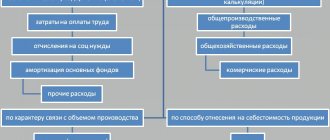Account 73 in accounting
In addition to remuneration or accountable amounts, other situations may arise in an organization regarding the accounting of settlements with personnel, for example, accounting for shortages or the use of personal property. For these purposes, account 73 “Settlements with personnel for other operations” is used.
Let's look at other situations:
- Providing loans;
- Compensation for material damage;
- Payment for the use of personal property (for example, a car);
- Reimbursement for telephone calls;
- Other calculations.
For each situation, you can select a separate subaccount:
Characteristics of account 73 Settlements with personnel for other transactions:
- It is an active-passive account. The debit balance characterizes the debt of the employee, and the credit balance - of the organization;
- Analytical accounting is carried out in the context of enterprise employees.
Account 73 “Settlements with personnel for other operations”
This material, which continues the series of publications devoted to the new chart of accounts, analyzes account 73 “Settlements with personnel for other operations” of the new chart of accounts. This commentary was prepared by Y.V. Sokolov, Doctor of Economics, Deputy. Chairman of the Interdepartmental Commission on Reforming Accounting and Reporting, member of the Methodological Council on Accounting under the Ministry of Finance of Russia, first President of the Institute of Professional Accountants of Russia, V.V. Patrov, professor of St. Petersburg State University and N.N. Karzaeva, Ph.D., deputy. Director of the audit service of Balt-Audit-Expert LLC.
Account 73 “Settlements with personnel for other operations” is intended to summarize information on all types of settlements with employees of the organization, except for settlements for wages and settlements with accountable persons.
Sub-accounts can be opened to account 73 “Settlements with personnel for other operations”:
73-1 “Calculations for loans granted”, 73-2 “Calculations for compensation for material damage”, etc.
Subaccount 73-1 “Settlements for loans provided” reflects settlements with employees of the organization for loans provided to them (for example, for individual and cooperative housing construction, the acquisition or construction of garden houses and the improvement of garden plots, starting a household, etc.).
The debit of account 73 “Settlements with personnel for other operations” reflects the amount of the loan provided to an employee of the organization in correspondence with account 50 “Cash” or 51 “Cash accounts”.
For the amount of payments received from the borrower employee, account 73 “Settlements with personnel for other operations” is credited in correspondence with accounts 50 “Cash”, 51 “Settlement accounts”, 70 “Settlements with personnel for wages” (depending on the accepted payment procedure).
Subaccount 73-2 “Calculations for compensation for material damage” takes into account calculations for compensation for material damage caused by an employee of the organization as a result of shortages and thefts of monetary and commodity-material assets, defects, as well as compensation for other types of damage.
In the debit of account 73 “Settlements with personnel for other operations,” the amounts to be recovered from the guilty parties are included in the credit of accounts 94 “Shortages and losses from damage to valuables” and 98 “Deferred income” (for missing inventory items), 28 “Defects in production” (for losses from defective products), etc.
In the credit of account 73 “Settlements with personnel for other operations”, entries are made in correspondence with the accounts: cash accounting - for the amounts of payments made; 70 “Settlements with personnel for wages” - for the amount of deductions from wages; 94 “Shortages and losses from damage to valuables” - for the amount of written off shortfalls in case of refusal to recover due to the unfoundedness of the claim.
Analytical accounting for account 73 “Settlements with personnel for other operations” is maintained for each employee of the organization.
Any organization may have settlements with its employees. First of all, payroll calculations are taken into account in account 70 “Settlements with personnel for wages”) and for accountable amounts (accounted for in account 71 “Settlements with accountable persons”). The compiler of the chart of accounts assumes that all other types of settlements should be accounted for in separate subaccounts of account 73 “Settlements with personnel for other transactions.” Here, first of all, subaccount 73.1 “Settlements on loans provided” is highlighted. They arise due to the fact that the administration of the organization sometimes issues him a loan, usually interest-free, (for the purchase of an apartment, a summer house, a plot of land and some other needs). If an employee receives a loan, then account 73.1 “Settlements for loans provided” is debited and cash accounts are credited. If interest is expected to be received, then an entry is made for their accrual:
Debit 73.1 “Settlements on loans provided” Credit 91.2 “Other income”
Further, for issued loans, two possibilities arise:
- or the loan with interest will be repaid;
- or the loan with interest will not be fully and/or partially repaid.
In the first case, the entries are obvious; they, as a rule, will depend on how the debt will be repaid:
- if directly in cash, then Debit 50 “Cash”;
- if through a bank - Debit 51 “Current accounts”;
- if from wages - Debit 70 “Settlements with personnel for wages”.
In all cases, account 73.1 “Settlements on loans provided” is credited.
Subaccount 73.2 “Settlements for compensation for material damage” takes into account settlements with employees of the enterprise for compensation for material damage caused by an employee of the organization as a result of shortages and thefts of monetary and inventory items, defects, as well as compensation for other types of damage.
Collection of amounts in compensation for commodity losses established based on the results of the inventory from financially responsible persons must be carried out in accordance with the Labor Code of the Russian Federation.
Financial liability for damage caused to the organization during the performance of labor duties is assigned to the employee, provided that the damage was caused through his fault. This liability is usually limited to the employee's average monthly earnings and should not exceed the full amount of damage caused, except as otherwise provided by law. Such cases include full financial responsibility, which the employee bears in accordance with the agreement on full financial responsibility concluded with the administration of the enterprise. Cases of full financial liability are established by Article 243 of the Labor Code of the Russian Federation.
When determining the amount of damage, only direct actual damage is taken into account; income not received is not taken into account.
Article 246 of the Labor Code of the Russian Federation states: “The amount of damage caused to the employer in the event of loss and damage to property is determined by actual losses, calculated on the basis of market prices prevailing in the area on the day the damage was caused, but not lower than the value of the property according to accounting data, taking into account the degree of wear and tear of this property.”
The procedure for collecting damages is determined by Article 248 of the Labor Code of the Russian Federation. Recovery of an amount of damage not exceeding the average monthly salary is carried out by order of the employer. The order can be made no later than one month from the date the amount of damage is established. If the monthly period has expired or the employee does not agree to voluntarily compensate for the damage caused, and the amount exceeds the employee’s average monthly earnings, then recovery is carried out in court.
The employee responsible for the damage may voluntarily compensate for it in full or in part. Compensation for damage by installments is allowed (under the written obligation of the employee).
For each payment of wages, the total amount of all deductions cannot exceed 20%, and in cases specifically provided for by law - 50% of the wages due to the employee (Article 138 of the Labor Code of the Russian Federation). The amount of deductions from wages when serving correctional labor cannot exceed, in accordance with Article 138 of the Labor Code of the Russian Federation, 70%.
The employee’s debt for compensation for damage is reflected in account 73 “Settlements with personnel for other operations” subaccount 2 “Calculations for compensation of material damage”. The balance sheet estimate of lost material assets, subject to compensation by the financially responsible person, is written off from account 94 “Shortages and losses from damage to valuables” to account 73.2 “Settlements with personnel for other operations” “Settlements for compensation of material damage”:
Debit 73 “Settlements with personnel for other operations” subaccount 2 “Calculations for compensation of material damage” Credit 94 “Shortages and losses from damage to valuables”
If the cost of missing goods is recovered from the perpetrators at prices exceeding their book value, then the difference between the cost of the missing valuables credited to account 73 “Settlements with personnel for other operations” subaccount 2 “Calculations for compensation of material damage” and their value reflected on account 94 “Shortages and losses from damage to valuables”, is credited to account 98 “Deferred income” subaccount 4 “The difference between the amount to be recovered from the guilty parties and the book value for shortfalls of valuables”:
Debit 73 “Settlements with personnel for other operations” subaccount 2 “Calculations for compensation of material damage” Credit 98 “Deferred income” subaccount 4 “The difference between the amount to be recovered from the guilty parties and the book value for shortages of valuables”
As the amount due is collected from the guilty person, the following is reflected in the following entries:
Debit 50 “Cash” Credit 73 “Settlements with personnel for other operations”, subaccount 2 “Settlements for compensation of material damage”
or when deducting amounts from wages to pay off debt:
Debit 70 “Settlements with personnel for wages” Credit 73 “Settlements with personnel for other operations” subaccount 2 “Settlements for compensation of material damage”
The above difference is written off from account 98 “Deferred income” subaccount 4 “The difference between the amount to be recovered from the guilty parties and the book value for shortages of valuables” to the account of financial results:
Debit 98 “Deferred income” subaccount 4 “The difference between the amount to be recovered from the guilty parties and the book value for shortages of valuables” Credit 91 “Other income and expenses” subaccount 1 “Other income”
Shortages of valuables identified in the current year, but relating to previous periods, recognized by financially responsible persons or for which there are decisions of judicial authorities to recover from the guilty persons, are reflected in the debit of account 94 “Shortages and losses from damage to valuables” and the credit of account 98 “Income future periods."
At the same time, account 73 “Settlements with personnel for other operations” (sub-account “Settlements for compensation of material damage”) is debited with these amounts and account 94 “Shortages and losses from damage to valuables” is credited. As the debt is repaid, account 91 “Other income and expenses” subaccount 1 “Other income” is credited and account 98 “Deferred income” is debited.
Example
Based on the results of the inventory of goods, a shortage of goods in the amount of 180 rubles was established. at sales prices. The trade margin is 20% of the purchase price of the goods. According to the calculation of commodity losses as a result of natural loss, a shortage was established within the limits of natural loss norms in the amount of 42 rubles. The market price (with a markup) of the goods on the day of inventory was 170 rubles.
Let's consider two options for reflecting transactions to write off commodity losses in the accounting accounts:
Option 1. Operational accounting is kept at purchase prices (Table 1). Option 2. Operational accounting is kept at sales prices (Table 2)
Table 1
Accounting entries to reflect inventory results when maintaining records at purchase prices
| No. | Contents of economic and financial transaction | Debit | Credit | Sum |
| Product shortage reported | 180 : 120 * 100 = 150 | |||
| The shortage of goods was written off as a result of natural loss | 42 : 120 * 100 = 35 | |||
| The shortage of goods caused by the fault of the financially responsible person has been written off | 138 : 120 * 100 = 115 | |||
| The difference between the amount collected and the cost of goods at discount prices is reflected in the accounting | 170 — 115 = 55 | |||
| Repayment of debt by a financially responsible person by depositing money into the cash register | ||||
| Deferred income for reimbursable losses was written off by the financially responsible person |
table 2
Accounting entries to reflect inventory results when maintaining records at sales prices
| No. | Contents of economic and financial transaction | Debit | Credit | Sum |
| Product shortage reported | 180 : 120 * 100 = 150 | |||
| Trade markup on goods written off | 180 : 120 * 20 = 30 | |||
| The shortage of goods was written off as a result of natural loss | 42 : 120 * 100 = 35 | |||
| The shortage of goods caused by the fault of the financially responsible person has been written off | 138 : 120 * 100 = 115 | |||
| The difference between the amount collected and the cost of goods at discount prices is reflected in the accounting | 170 — 115 = 55 | |||
| Repayment of debt by a financially responsible person by depositing money into the cash register | ||||
| Deferred income for reimbursable losses was written off by the financially responsible person |
Analytical accounting of calculations is carried out separately for each employee.
Accounting account 73 is an active-passive account “Settlements with personnel for other operations.” Let's consider what transactions account 73 is used to account for, what accounts account 73 corresponds with, as well as typical entries in account 73 using the example of transactions of issuing a loan to an employee, compensation for the use of personal vehicles for business purposes and writing off shortages.
Correspondence of account 73 with other accounts
Table 1. By debit of account 73:
| Dt | CT | Wiring Description |
| 73.02 | 20, 29,23 | Damage caused to the main, servicing or auxiliary production is written off to the perpetrators |
| 73.02 | 28 | The marriage is blamed on the guilty parties |
| 73.01 | 50, 51, 52, 57, 62 | A loan was issued from the cash desk, from a current or foreign currency account, by transferring transfers or by endorsing buyer bills |
| 73.03 | 50, 52 | Payment of rental of personal property or reimbursement of amounts for the use of personal property through a cash register or bank account |
| 73.03 | 68 | Withholding personal income tax from other transactions |
| 73.03 | 69 | Debt on insurance premiums for other operations |
| 73.03 | 76 | Insurance payments for personal insurance are reflected |
| 73 | 79 | Transfer of debt upon transfer from a separate division |
| 73.03 | 81 | Issue of own shares |
| 73.01 | 91.01 | Interest on loans issued |
| 73.02 | 94 | The amounts of shortages and damages within the book value were written off |
| 73.02 | 98.4 | Difference between recoverable and book value, shortfalls for previous years |
| 73.02 | 99 | Amounts of damage from emergency events (fire, accident) are written off to the perpetrators |
Table 2. For the credit of account 73:
| Dt | CT | Wiring Description |
| 20 | 73.03 | Accrual of rental of personal property or reimbursable amounts for the use of personal property through a cash register or checking account |
| 41 | 73 | Receipt of goods through payment of debt |
| 50, 51, 52 | 73 | Receipt of payment from employees (loan payment, compensation for shortages, losses from defects) |
| 70 | 73 | Deduction of employee debt from wages |
| 76 | 73 | Amounts of compensation under the employee's insurance contract |
| 91.02 | 73 | Write-off of unreceivable debt |
| 94 | 73 | The claim for shortages is not justified, write-off of debt for shortages |
| 99 | 73 | Write-off of debt in connection with emergency situations in which an employee died |
Postings to account credit 73
73 account is credited when the employee makes a payment for previously billed amounts or when compensation payments are calculated.
Account assignments for the loan account. 73
| Dt | CT | Characteristics of a business transaction |
| 50 | 73 | The amount of funds deposited into the cash register to repay the debt for the purchase of specialized clothing is reflected. |
| 51 | The employee transferred the amount of debt for the purchased apartment to the organization’s current account | |
| 76 | The employee received the amount of insurance compensation | |
| 92 | The amount of the employee's outstanding receivables was written off after the expiration of the claim period | |
| 10 | Compensation was awarded for purchased fuel for a personal car used at work | |
| 19 | The amount of input VAT on purchased fuel is reflected |
Accounting account 73 is one of the ways to reflect settlements with employees. Not all payments and collections can be reflected on accounts 70 and 71, which explains the use of an additional account that simplifies accounting.
Examples of using account 73 in accounting
Example 1. Accounting for a loan to an employee in account 73
On December 1, employee Petrova A.S. A loan in the amount of 70,000 rubles was issued. for a period of 1 year at 6%. The loan is repaid with salary deductions in the amount of RUB 6,000. monthly. The Central Bank refinancing rate was 10%.
Let's make the calculation:
- Interest - 70,000 rubles. * 6% / 366 days a year * 31 calendar days = RUB 355.74;
- Material benefit – 70,000 rubles. * (2/3 * 10% - 6%) / 366 days a year * 31 calendar days = 39.53 rubles;
- Personal income tax – 39.53 * 35% = 13.84 rubles.
The solution to the example with postings to account 73 in the table:
| date | Account Dt | Kt account | Amount, rub. | Wiring Description |
| December 01 | 73.01 | 51 | 70 000 | The loan amount was issued to the current account |
| December 03 | 73.01 | 91.01 | 355,74 | Interest accrued |
| December 10 | 51 | 73.01 | 355,74 | The employee paid the interest |
| 31th of December | 70 | 68 | 13,84 | Personal income tax accrued on material benefits |
Example 2. Accounting for compensation for the use of a personal car in account 73
Employee Petrov E.P. by agreement with the employer, uses his personal car for business trips. The amount of monthly compensation is set at 2,000 rubles. (within the normal range - 1,200 rubles and 800 rubles in excess of the norm).
Solution to the example with postings to account 73:
| date | Account Dt | Kt account | Amount, rub. | Wiring Description |
| Accounting | ||||
| December 01 | 44 | 73.03 | 2 000 | Compensation awarded for the use of a personal car |
| 31th of December | 73.03 | 50 | 2 000 | Compensation paid |
| If PBU 18/02 is applied | ||||
| WELL | 44 | 73.03 | 1 200 | Compensation within normal limits |
| ETC | 44 | 73.03 | 800 | Compensation above the norm |
Important! Personal income tax is not charged on amounts of compensation for the use of personal property, and these amounts are also not subject to insurance contributions (clause 3 of Article 217 of the Tax Code of the Russian Federation).
Example 3. Shortages were identified during inventory
The trading company Tele Systems Fon LLC carried out an inventory of goods in warehouses as of December 1. As a result of the inventory, a shortage totaling 5,000 rubles was identified. The amount within the limits of natural loss norms was written off as business expenses - 4,000 rubles, the rest - to the guilty parties.
Solution to the example with postings to account 73:
| date | Account Dt | Kt account | Amount, rub. | Wiring Description | A document base |
| Write-off of losses | |||||
| December 01 | 94 | 41 | 5 000 | Shortage identified | Certificate of write-off of goods TORG-6 |
| December 01 | 44 | 94 | 4 000 | The shortfall was written off as business expenses within the normal limits. | |
| December 01 | 73.02 | 94 | 1 000 | The shortage is written off to the responsible person | |
Examples of postings, reflected in the balance sheet
Below are typical transactions for account 73 using its subaccount 73.1:
- Dt 73.1 Kt 50 - issuing an advance to an employee for the purchase of livestock;
- Dt 73.1 Kt 51 - borrowed funds for the construction of a house were transferred to the employee’s bank account;
- Dt 73.1 Kt 10 - provision of a loan to an employee in the form of construction materials;
- Dt 73.1 Kt 91 - accrual of interest for the use of borrowed funds;
- Dt 50 Kt 73.1 - receipt of funds to the enterprise’s cash desk to repay the debt;
- Dt 51 Kt 73.1 - transfer of funds to pay for the loan to the organization’s current account;
- Dt 70 Kt 73.1 - deduction from the employee’s earnings of the amount of borrowed funds and interest;
- Dt 91.2 Kt 73.1 - writing off the amount of unrepaid debt for company expenses.
From the above entries it is clear that the company has the right to withhold the amount of debt from the employee’s wages. The total amount of deductions should not be more than 20% of earnings. If the employee has previously written an application to repay the debt on account of salary (the amount is arbitrary at the request of the employee), the employer can withhold an amount in excess of 20% in accordance with the document.
The occurrence of employee debt to the enterprise is reflected in the enterprise’s balance sheet in line 1230 “Accounts receivable”. The amount is included in this line regardless of the period during which loan payments are expected.
Correspondence and postings
Account 73 basically has correspondence with the most acceptable instruments, the accounts on which money flows in the enterprise:
- if the income is 73, then the expense is 99, , 84, 71, 51, 23;
- when the credit is 73, then the debit is 50, 70, 91, 51, 76, 99.
The list can be continued, since it depends on the size of the company and how many production events occur in it per month or day. It is important to understand that the amount in receipt shows how much the receivables have increased.
The procedure means:
- the cashier handed out cash;
- the accountant made the payment through the bank;
- material damage or defect was caused by a specific employee;
- issuance or accrual of debt amounts.
In this case, the following accounts are debited:
- maintaining monetary records;
- on which production costs are allocated;
- calculations;
- financial results.
If a worker owes a debt to the company, this amount will be reflected in the income line; repayment will show the loan. The accounting policy of each company regulates the use and number of subaccounts.
If the financier decided to use subaccount 73.1 to account for the issuance of loans, then business transactions will look like the following entries:
- the employee took money from the cash register for repairs - 73.1/50;
- there were bank transfers for construction – 73.1 / 51;
- the employee deposited the debt into the cash register - 50 / 73.1;
- the debt was repaid to the current account - 51 / 73.1;
- deduction of amounts from salary – 70 / 73.1;
- unrecovered debt written off by the organization – 91.2 / 73.1.
Management has the right to withhold the debt from the debtor's earnings. When this is not enough, the balances are written off as a financial result.
Definitions and characteristics
Any citizen, when getting a job, expects long-term cooperation.
The management has its own plans for the professional contingent. As a result, a connection arises between the employee and the employer in the field of financial relations, which can be both positive and negative. Sometimes it is not enough to account only for wages or expenses issued from the cash register for reporting. The employee is provided with a loan for the purchase of real estate or, due to his fault, material damage to the enterprise occurred, then other transactions with him will need to be recorded by the institution.
On account 73, the accountant reflects all business transactions with personnel; the source of funds on it is the company. This accounting instrument is characterized as active-passive. If it contains a one-way debit balance with signs of activity on the account, it means that the employee has a debt to the company.
To correctly use account 73 and correctly reflect a financial transaction, you need to understand its structure, purpose and methods of application.
The purpose of creating separate accounting was the situations that arise in organizations:
- loan issued;
- deductions were made for material shortages;
- damages for using the car have been paid;
- Telephone costs were reimbursed.
The withdrawn balance from settlements with employees for other financial interactions participates in the formation of the balance, so it is important to know the following points:
- all material assets, property of the enterprise, cash equivalent belong to active accounts;
- receipts, which are a means of profitability, are classified as passive.
Active accounts represent the placement of funds belonging to the organization. This includes:
- goods;
- finished products;
- OS;
- NMA;
- money.
Their composition and structure are characterized by:
- all incoming materials in monetary terms are reflected in the receipt;
- write off the amounts in the credit column;
- Both the beginning and ending balances have a debit balance.
With the help of passive accounts, the movement of money from sources that belong to the enterprise on whose behalf they conduct accounting is controlled.
Please note:
- the source has increased, the value is posted as a credit, decreased - as a debit;
- The balance both at the beginning and at the end of the reporting period is in credit.
In general postings there are interactions between active and passive accounts.
From the analysis it follows that the register on which all operations related to personnel are taken into account is number 73. It belongs to:
- to an active-passive account, in which the debit balance indicates the worker’s debt, the credit balance indicates the company’s debt;
- The analytical accounting section represents the movement of funds between employees of the organization.
Correct correspondence allows you to monitor compliance with all rules and regulations and adjust balance sheet items.








